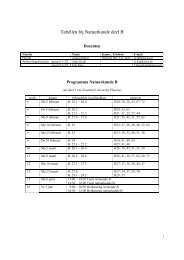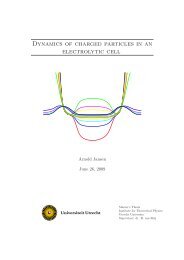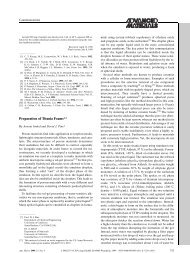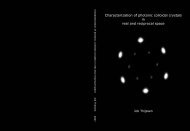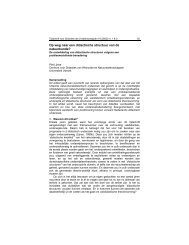Sedimentation Equilibrium of Mixtures of Charged Colloids
Sedimentation Equilibrium of Mixtures of Charged Colloids
Sedimentation Equilibrium of Mixtures of Charged Colloids
Create successful ePaper yourself
Turn your PDF publications into a flip-book with our unique Google optimized e-Paper software.
The next constant that can be solved is b n−1 . From the relation between b n−1and b n , using equation (4.22),where ξ n−1 can be found by the normalisation1H∫ xnx n −ξ n−1dxb n−1 = b n + t n + c n−1 ξ n−1 (4.25)()b n + t n − c n−1 (x − x n ) = ¯η (4.26)we find an expression for b n−1 and thus, for all b i . By repeating the stepsfrom equation (4.24) we find expressions for all constants b n and layer widthsξ i√2Hρ s¯ηπση(x i ) = b n =3+ (b3ZnL 2 n+1 + t n+1 ) 2 (4.27)nξ i = 3Z2 i L iρ s πσ 3 (b i − b i+1 − t i+1 ) (4.28)Figure 4.17 shows a comparison with the full numerical solutions. The dottedlines represent the approximation. The left figure shows an approximation<strong>of</strong> figure 4.1. The right figure shows the packing fractions <strong>of</strong> a systemwith colloidal charge number Z = (200, 250, 300), and gravitational lengthL = (0.4, 0.7, 1)mm, and the usual system parameters (see tab. 4.1). Althoughthe slope model calculates the equilibrium properties in an instant,and can even be done by hand, the Poisson-Boltzmann calculations are consideredmore reliable, and do not need the condition <strong>of</strong> pure layers. Especiallythis last condition is not <strong>of</strong>ten met for the systems considered in this thesis.An additional problem with the slope model is the jump constant. Multiplecomparisons with PB-calculations show that it is indeed proportional tot n ∝ ((Z N L n ) −2 − (Z n−1 L n−1 ) −2 ), but the proportionality constant provednot always equal to σ 3 /48λ B .36




